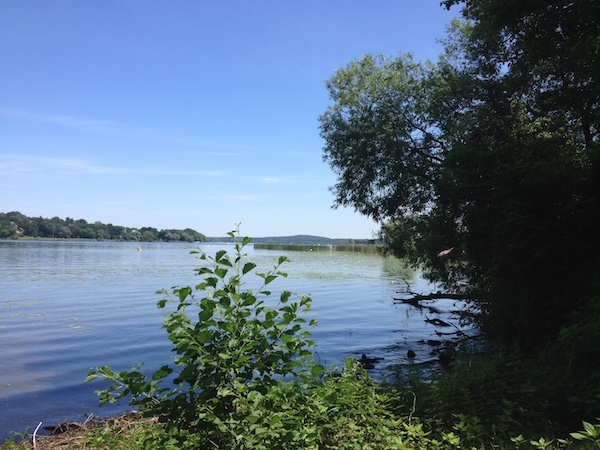
For Italian version please scroll down
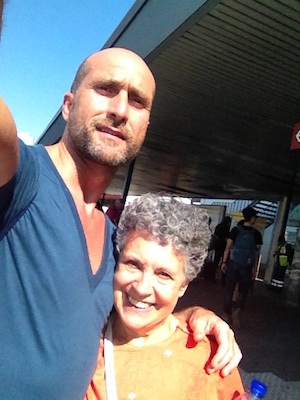
Life in Berlin
Anyone who has visited Berlin during the cold months, can not have a complete picture or a clear image of the city.
Although the dry leaves of autumn that litter the streets with a maroon and yellow cloak, or the meadows white with snow in winter can be suggestive, the metamorphosis that Berlin undergoes in the spring and then the summer is not just about the scenery, but regards the very air of the city.
The air becomes electric, contagious, detonating not only nature but also the enthusiasm of the people.
The dark and cold of the winter months is contrasted by the warm spring light, which rises in the early hours of the day and lingers until almost midnight before disappearing into the starry sky of June. Already in May the melancholy bare trees, reborn under the pressure of bursting nature, are filled with colours and lush fronds of fruit and foliage. In summer the lonely roads which in January are crossed by people holding their heads close between their shoulders to avoid losing heat, are crowded with people who rush to occupy every green space, to undress and enjoy every ray of sunshine. The need, both morning and evening, to be closed in bars or smoky rooms, is overcome by the possibility of being outdoors late into the night.
I mean, anyone who lives in Berlin knows what a joyful and positive effect the arrival of summer has on their mood and even on their body, and those who have not tried this difference, can not expect to really know the city.
It is for this reason that, after waiting a few years, I was very pleased to receive a visit from my mother precisely in this period of change.
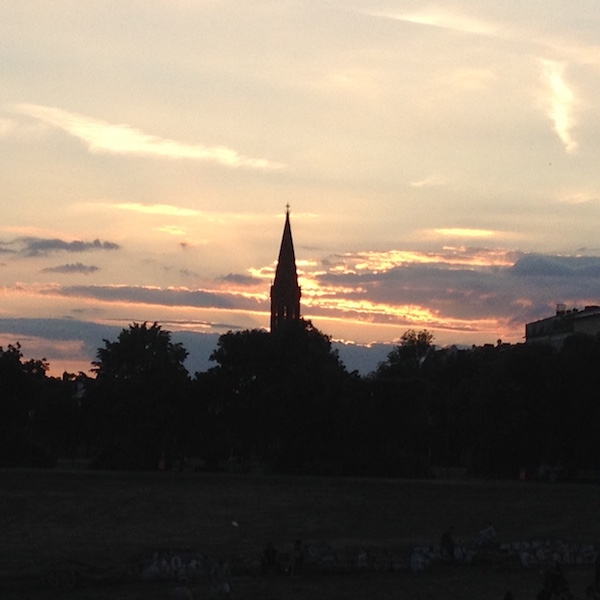
Another side of the city
For the first time since I live in Berlin, I was able to show another side of the city.
When she arrived, it was late afternoon, but thanks to light and mild climate, we took a short walk between Kreuzberg and Neukölln. We walked along the canal, I showed the Barettino, where sometimes I go for a hearty breakfast or during the evening for an Italian aperitif with some friends, I showed her the ballroom where I celebrated my last birthday, the public laundry where I used to take my laundry when I moved to Berlin, and other places from my daily life. Given the variety of restaurants and cuisines from everywhere, after a long list of possibilities, I let my mother choose where to dine, with the understanding that we would try different things every day. The first night was Thai cuisine, in Weserstraße. At the outdoor tables we ate rice and duck while drinking a refreshing cocktail.
But the biggest news was the program for the following days.
Instead of going to museums, like we usually do in winter time, I chose as the destination of our tours the most beautiful parks in the surrounding area.
Potsdam Sanssouci

On the second day, in fact, we went to Potsdam and visited the Sanssouci gardens.
Potsdam, a city west of Berlin, is the capital of Brandenburg.
For centuries it was preferred by the Prussian kings, and not only them, to today’s Bundeshauptstadt, the federal capital.
If today Berlin is viewed with a mixture of distrust but also with envy by other German cities, more provincial and conservative but richer and cleaner than the capital, in the centuries before WWI it was not at all popular – too Protestant and too far to the East from the economic, technology and cultural centre of the country.
In 1946, when he was still mayor of Cologne, Adenauer was opposed to the idea of making Berlin the capital of Germany, and when he was elected head of government (1949), he carefully avoided travelling to the capital, except when it was strictly necessary.
In 1870, Guglielmo I would also have preferred that Potsdam be the capital of the new empire.
With its famous Stadtschloss (city castle), which the kings favored to that of Charlottenburg, Potsdam was particularly loved by Frederick the Great, who designed and built his summer residence – the Sanssouci palace – with terraced vineyards, and by Guglielmo I, who in 1833 built the Babelsberg Castle on a hill overlooking a bank of the Havel River.
And so, alternating walking on foot with comfortable tours of the city on board an open-air bus, we saw the typical low houses in the nineteenth century old town, the majestic Brandenburg Gate, built in 1770 to celebrate Prussia’s victory in the Seven Year War against Austria, the beautiful Nikolaikirche in Alter Markt square, built in 1830 in the neo-classical style, the Holländisches Viertel (Dutch quarter), the Alexandrowka (Russian district), the castle Sanssouci, the summer residence of Prussian King Friedrich II and its park.
On the way back, leaving the royal Potsdam behind us, we went to Alexanderplatz and due to the unusual heat we saw children bathing in the fountain at the foot of the television tower – a really unusual sight for Berlin, but perfectly in tune with its unpredictable and eccentric spirit.
In the evening, for dinner, a giant Schnitzel in Richardplatz!
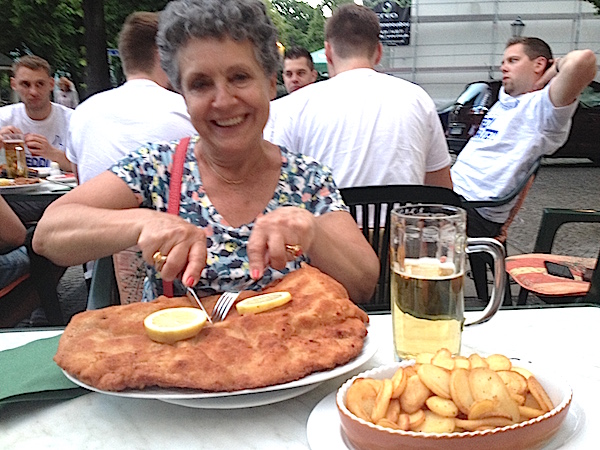
Treptower Park
On the third day, in the company of some friends, we went to Treptower Park, a very large city park, which runs along the Spree river.
We found a lawn in the sun in front of a small lake beside the Sowjetisches Ehrenmal (Soviet Memorial) and, with our towels, we lay on the grass for our picnic.
It was nice to show to my mother the things that I always tell her. The people who flock to the parks at the first sun and who swim in frozen lakes, the large number of dogs that roam free, ready to respond to their master’s first command, the boys with music and beers that are camping in a circle laughing loudly, young families with blonde children running in the great outdoors or playing in the playgrounds, the men who collect bottles for the pfand (deposit), those who practice walking on wire strung from one tree to another, those who drank the day before who are sleeping in the shade, people of all ages reading and sunbathing naked.
While we were there, conversing and looking around, our day became unexpectedly lively. A black cloud dumped rain on our heads for about an hour. We therefore covered our things and sheltered under the trees, waiting for the sun to come back and everything to resume as if nothing had happened.
After a while, in fact, sitting on a wooden platform near the lake, we could enjoy our brunch with the typical scent of wet grass all around us.
Directly from there we went to the Sunday fleamarkt in Boxhagener Platz with a friend’s car.
In Berlin there are an incredible number of open air markets, and Boxhagener Platz, although not the most famous or the most typical, is one of the ones that I prefer. There are many bargains and each time I walk through the stalls I am seized by a desire to buy useless things that I would not know where to put.
After having looked around between the stalls and stopping for a beer in a bar we ended the evening eating sushi in Glogauer Str.
Hasenheide Park
On Monday, because of my many business appointments, I could only dedicate a few hours in the morning to my mother. Nevertheless, even on the fourth day, we could not miss a long walk in a city park. This time it happened to be Hasenheide, which owes its name to the fact that since 1678 the park, which alternates meadows with woodland, was a place for hunting hares.
Hasenheide is the park I frequent the most because it is located just two minutes from where I live so it is the ideal place to get away as soon as there is the possibility of sunbathing.
The park is very large, there is an area where children can play and can get close to many animals (there are even camels!), there is a large fenced area where the dogs play, a valley where they often organize picnics, there is a nudist area, a large lawn where you often see people doing gymnastics, a beautiful garden with colourful flowers and benches all around, an area with an open-air cinema, one where there are sometimes fairground rides, several wooded areas with squirrels and foxes, a pond with geese, swans and ducks, and big green spaces to enjoy.
In the afternoon, as I held my pilates classes at my studio, my mother was at home preparing typical Neapolitan finger food for the dinner we had planned following pilates. It is impossible to describe the smells and flavours of stuffed fried pizza with ricotta cheese and ham, pizza with tomato sauce, croquet potatoes, battered eggplant, and rice balls.
Between music, stories and laughter the evening ended for everyone with a smile and a full stomach.
Pfaueninsel
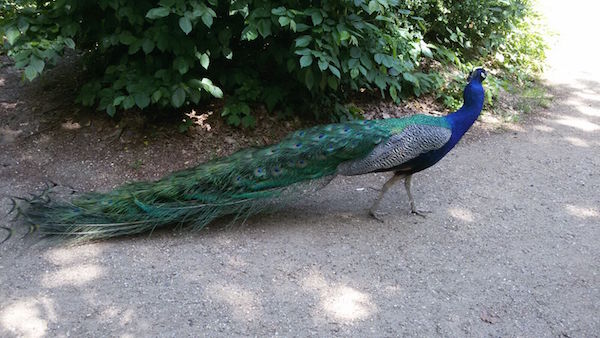
The next morning, at the dawn of the fifth day, we quickly prepared ourself to go to Wannsee. This time our destination was Pfaueninsel (Peacock Island).
In 1795 Frederick William II transplanted a colony of peacocks onto a small island in the Havel River, which is now a nature reserve.
Besides the Gothic castle there is the Luistempel (a small greek style temple), the Meierei (dairy), a rose garden and a fountain situated on a small hill, but the real attraction of the island are the peacocks walking freely along the paths and lawns of the park around the area where the aviaries are located.
Walking along the perimeter of the island is very fascinating. For a moment the sight of water can make you forget that it is a lake and give the impression of being on a small island in the Mediterranean.
We followed the entire outer path, enjoying the view, the sounds and the smells of the Pfaueninsel. Without maps or directions, we were guided by the shrill and sharp cries of the birds up to the aviaries and there we met peacocks with their long and regal tails, a flock of sheep grazing, pheasants and parrots.
Despite the hours spent walking, our day was not over with the excursion to Wannsee. With my tireless mother we went to dinner with friends in a residential area of the city that she did not yet know.
Volkspark Humboldthain
On the sixth day, perhaps in tune with the feelings of melancholy caused by the thought of my mother leaving the next day, the program included a tour of the Jewish quarter in Mitte, a stop at Der Berliner Mauer and, so as not to betray the spirit of the holiday, a visit to another park: Der Volkspark Humboldthain in Wedding.
With the guidance and pleasant company of my friend Lucio Campoli, a brilliant potter that I met in Berlin a few years ago, we went first to Mitte and then to Prenzlauer Berg to visit what remains of the wall. In short, the theme of separation was prevalent, but it did not stop us from enjoying our daily mission: yet another visit to a park.
The week flew by, but it was intense and full of wonderful experiences. Moreover, sharing is the most effective means of communication. I was able to show my mother a new side of my adopted city, again giving her one more reason to understand deeply the reasons for my choice and my love for Berlin.
On the day of departure and those subsequent it was raining in Berlin.
ITALIAN VERSION
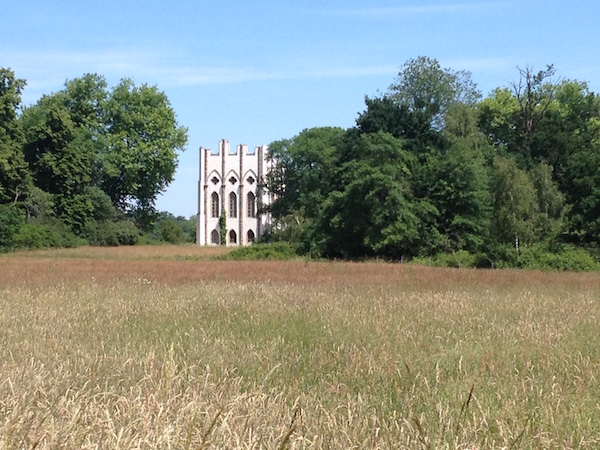
Chi ha visitato Berlino durante i mesi freddi, non può avere una visione completa né un’immagine chiara della città.
Per quanto possano essere suggestive le foglie secche autunnali che ricoprono le strade di un manto rossiccio e giallo, o i prati imbiancati di neve in inverno, la metamorfosi che subisce Berlino in primavera e poi d’estate, non riguarda solo i paesaggi, ma l’aria stessa della città.
L’aria diventa elettrica, contagiosa, fa esplodere la natura ma anche l’entusiasmo della gente.
Al buio e al freddo dei mesi invernali si contrappone la luce tiepida primaverile, che sorge alle prime ore del giorno e si attarda sin quasi alla mezzanotte, prima di spegnersi nel cielo stellato di giugno. Già verso maggio, i malinconici alberi spogli, rinascono sotto la spinta della natura prorompente, riempendosi di colori e di fronde rigogliose cariche di frutti e fogliame. D’estate, le strade solitarie che a gennaio si attraversano con la testa chiusa tra le spalle per non disperdere calore, si affollano di gente che corre a occupare ogni spazio verde per spogliarsi e godere di ogni singolo raggio di sole. La necessità, sia di mattina che di sera, di chiudersi in bar o locali pieni di fumo, viene superata dalla possibilità di stare all’aria aperta fino a tarda notte.
Insomma, chi vive a Berlino sa che effetto gioioso e positivo abbia sull’umore e anche sul corpo l’arrivo della bella stagione, e chi non ha provato questa differenza, non può pensare di conoscere veramente la città.
È per questo motivo che, dopo aver atteso qualche anno, sono stato molto contento di ricevere, la visita di mia madre proprio in tale periodo di cambiamento.
Un’altra faccia della città

Per la prima volta, da che vivo a Berlino, sono riuscito a mostrarle un’altra faccia della città.
Quando è arrivata, era già pomeriggio, ma grazie alla luce e al clima mite, abbiamo un po’ passeggiato tra Kreuzberg e Neükolln. Abbiamo camminato lungo il canale, le ho mostrato il Barettino, dove talvolta vado a fare una ricca colazione o di sera a prendere un aperitivo all’italiana con qualche amico, le ho fatto vedere il locale in cui ho festeggiato il mio ultimo compleanno, la lavanderia pubblica dove facevo il bucato appena mi trasferii a Berlino e altri luoghi della mia vita quotidiana. Data la varietà di ristorantini e cucine tipiche di ogni dove, dopo una lunga lista di possibilità, le ho fatto scegliere dove cenare, con l’intesa di provare ogni giorno cose differenti. La prima sera è stata cucina Thai, sulla Weserstraße. Seduti ai tavoli all’aperto abbiamo mangiato riso e anatra bevendo un cocktail dissetante.
Ma la novità più grande, è stata il programma per i giorni seguenti.
Invece di andare per musei, come d’inverno, ho scelto come meta dei nostri giri, tutti i più bei parchi nei dintorni.
Potsdamm Sanssouci

Il secondo giorno, infatti, siamo andati a Potsdam e abbiamo visitato i giardini di Sanssouci.
Potsdam, città a ovest di Berlino, è la capitale del Brandeburgo.
Per secoli è stata preferita dai regnanti prussiani, e non solo, all’odierna Bundeshauptstadt, la capitale federale.
Se oggi Berlino è vista con un misto di diffidenza ma anche d’invidia dalle altre città tedesche, più provinciali e conservatrici ma più ricche e ordinate della capitale, nei secoli passati fino al primo dopoguerra, non era per nulla amata; troppo protestante e spostata a Est rispetto al baricentro economico, tecnologico e culturale del Paese.
Nel 1946, quando era ancora sindaco di Colonia, Adenauer si oppose all’idea di farne la capitale della Germania, e quando fu eletto capo del governo (1949) evitò accuratamente di recarsi nella capitale, se non quando fu strettamente tenuto a farlo.
Anche Guglielmo I, nel 1870, avrebbe voluto che la capitale del nuovo impero fosse Potsdam.
Con il suo celebre Stadtschloss (letteralmente castello cittadino), che i re prediligevano a quello di Charlottenburg, Potsdam era stata particolarmente amata da Federico II il Grande, il quale progettò e vi fece costruire la sua residenza estiva – il palazzo di Sanssouci – con il vigneto a terrazze, e da Guglielmo I che nel 1833 vi fece costruire il Castello di Babelsberg su una collina a strapiombo su una riva del fiume Havel.
E così, alternando passeggiate a giri della città fatti comodamente seduti su un bus all’aperto, abbiamo visto le tipiche case basse dell’800 del centro storico, la maestosa Porta di Brandeburgo, fatta costruire nel 1770 per celebrare la vittoria della Prussia nella guerra dei Sette Anni contro l’Austria, la splendida Nikolaikirche, costruita nel 1830 nella piazza Alter Markt, in stile neoclassico, l’Holländisches Viertel (quartiere olandese), l’Alexandrowka (il quartiere russo), il castello Sanssouci, la residenza estiva del re prussiano Federico II e il suo parco.
Al ritorno, lasciata alle nostre spalle la regale Potsdam, siamo passati per Alexanderplatz e, a causa dell’insolito caldo, abbiamo visto bambini fare il bagno nella fontana a gradoni proprio ai piedi della torre della televisione: spettacolo veramente insolito per Berlino, ma perfettamente in sintonia con il suo spirito imprevedibile ed eccentrico.
Per cena, Schnitzel (la cotoletta viennese) gigante in Richardplatz!
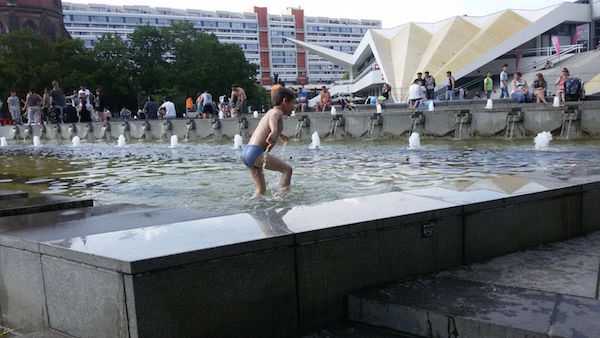
Treptower Park
Il terzo giorno, in compagnia di alcuni amici, siamo andati a Treptower Park, un parco cittadino molto grande, che si sviluppa lungo la Spree.
Abbiamo trovato un prato al sole davanti a un piccolo lago al lato del Sowjetisches Ehrenmal (memoriale sovietico) e, con i nostri teli, ci siamo sdraiati sull’erba per il nostro pic nic.
È stato bello poter mostrare a mia madre le cose di cui sempre le racconto. Le persone che al primo sole si riversano nei parchi e fanno bagni nei laghi ghiacciati, il gran numero dei cani che scorrazzano liberi, pronti a rispondere al primo comando del padrone, i ragazzi con musica e birre che bivaccano in cerchio e schiamazzano a voce alta, le giovani famiglie con bambini biondissimi che corrono nei grandi spazi verdi o che giocano nelle zone loro dedicate, i tipi che girano raccogliendo le bottiglie per il pfand (vuoto a rendere), quelli che si esercitano a camminare sul filo teso da un albero all’altro, quelli sbronzi dal giorno prima che dormono all’ombra, persone di tutte le età nude a leggere e ad abbronzarsi.
Mentre eravamo lì, conversando e guardandoci intorno, la nostra giornata si è inaspettatamente movimentata. Un nuvolone nero ha scaricato pioggia sulle nostre teste per circa un’oretta. Quindi, coperte le nostre cose, al riparo sotto gli alberi, abbiamo aspettato che il sole tornasse e tutto riprendesse come se nulla fosse successo.
Dopo un poco, infatti, seduti su una piattaforma di legno sul lago, abbiamo potuto consumare il nostro brunch mentre tutt’intorno si alzava il profumo tipico dell’erba bagnata.
Direttamente da lì, con l’auto di un’amica, siamo andati al flohmarkt domenicale di Boxhagener platz.
A Berlino ci sono un numero incredibile di mercatini all’aperto, quello di Boxhagener platz, pur non essendo tra i più famosi o tra i più caratteristici, è uno di quelli che preferisco. Ci si trovano tantissime occasioni e ogni volta che cammino tra le sue bancarelle vengo preso dal desiderio di comprare cose inutili che non saprei dove mettere.
Dopo aver curiosato tra i banconi e dopo esserci fermati a bere una birra in un bar, abbiamo terminato la serata mangiando sushi in Glogauerstr.
Hasenheide Park
Il lunedì, a causa dei miei molti appuntamenti di lavoro, ho potuto dedicare a mia madre soltanto poche ore durante la mattinata. Ciò nonostante, anche il quarto giorno, non potevamo perderci una lunga camminata in un parco cittadino. Questa volta è toccato a Hasenheide (brughiera delle lepri) che deve il suo nome al fatto che fin dal 1678 il parco, che alterna prati a zone boscose, era una riserva di caccia alle lepri.
Hasenheide è il parco che frequento maggiormente perché si trova a due minuti da dove vivo per cui è il posto ideale dove scappare appena c’è la possibilità di stendersi al sole.
Il parco è molto grande, c’è una zona in cui i bambini possono giocare e possono vedere da vicino molti animali (ci sono persino cammelli!), c’è un grande terreno recintato dove giocano i cani, una valle dove spesso si organizzano pic nic, c’è la zona nudisti, un vasto prato dove si vedono spesso persone fare ginnastica, un bellissimo giardino con fiori colorati e panchine tutt’intorno, una zona in cui si fa il cinema all’aperto, una dove vengono montate le giostre, diverse zone boscose con scoiattoli e volpi, un laghetto con oche, cigni e papere, e tanto altro spazio verde di cui godere.
Nel pomeriggio, mentre tenevo le mie classi di pilates presso il mio studio, mia madre era a casa che preparava la tipica frittura napoletana per la cena che abbiamo organizzato per il dopo pilates. Impossibile descrivere odori e sapori delle pizze fritte imbottite di ricotta prosciutto e formaggio, delle pizze al pomodoro, dei croquet di patate, delle melenzane fritte in pastella, e degli arancini di riso.
Tra musica, racconti e risate, la serata è finita per tutti con un sorriso e le pancia piena.
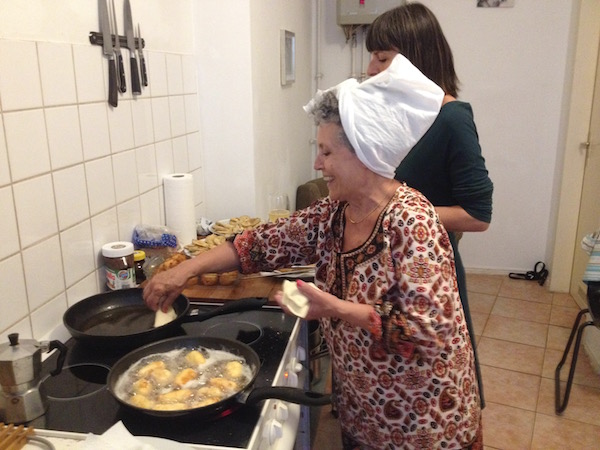
Pfaueninsel
Il mattino seguente, all’alba del quinto giorno, ci siamo preparati velocemente per raggiungere Wannsee. La destinazione, questa volta, era Pfaueninsel (l’isola dei pavoni).
L’isolotto, sul quale Federico Guglielmo II fece trapiantare una colonia di pavoni nel 1795, è una piccola isola e riserva naturale sul fiume Havel.
Oltre al castello gotico, al Luistempel (un piccolo tempio stile greco), la Meierei (la latteria), il roseto e una fontana situata su una piccola collina, la vera attrazione dell’isola, per l’appunto, sono i pavoni che camminano liberamente tra i viali e i prati del parco, tutt’intorno alla zona in cui sono collocate le voliere.
Camminare lungo il perimetro dell’isola è uno spettacolo molto affascinante. Per un attimo la vista dell’acqua può far dimenticare che si tratta di un lago e dare l’impressione di essere su un isolotto del Mediterraneo.
Noi abbiamo seguito tutto il sentiero più esterno, godendoci il panorama, i suoni e i profumi di Pfaueninsel. Senza cartine né indicazioni, ci siamo fatti guidare dagli striduli e acuti versi degli uccelli sino alle voliere e lì abbiamo incontrato pavoni dalle code lunghissime e regali, un gregge di pecore che pascolava, fagiani e pappagalli.
Nonostante le ore trascorse passeggiando, la nostra giornata non è finita con l’escursione a Wannsee. Con la mia instancabile madre, siamo andati a cena da amici in una zona residenziale della città che lei ancora non conosceva.
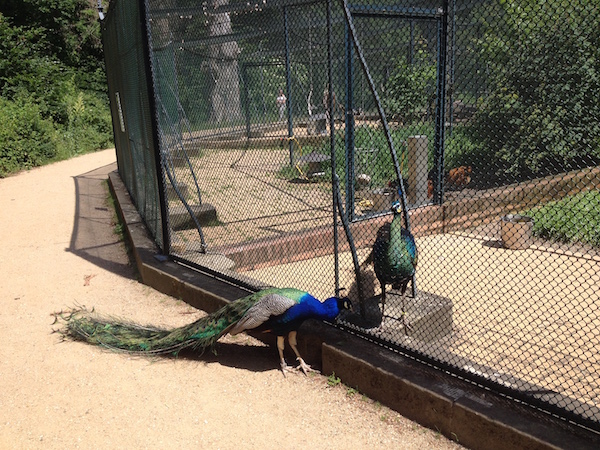
Volkspark Humboldthain
Il sesto giorno, forse in sintonia con il sentimento di malinconia provocato dal pensiero della partenza del il giorno seguente, il programma di marcia prevedeva un giro nel quartiere ebraico a Mitte, una sosta a Der Berliner Mauer e, per non tradire lo spirito della vacanza, la visita a un altro parco: Der Volkspark Humboldthain in Wedding.
Con la guida e la piacevole compagnia del mio amico Lucio Campoli, il bravissimo ceramista incontrato a Berlino qualche anno fa, siamo stati prima a Mitte e poi a Prenzlauerberg a visitare quel che resta del muro. Insomma il tema della separazione è stato ricorrente, ma non ci ha impedito di goderci la nostra missione quotidiana: l’ennesima visita a un parco.
La settimana è volata, ma è stata intensa e ricca di belle esperienze. Del resto la condivisione è il più efficace mezzo di comunicazione. Ho potuto mostrare a mia madre un nuovo lato della mia città adottiva dandole ancora una volta, una ragione in più per capire profondamente le ragioni della mia scelta e il mio amore per Berlino.
Il giorno della partenza e in quelli successivi, a Berlino pioveva.
